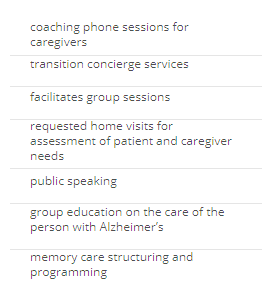
We coach in-home caretakers to use new methods of Habilitative Care for Dementia and Alzheimer’s family members and patients.
Perceptive and Sensation treatment
Research has proven that individuals with Alzheimer’s Disease can experience prolonged states of emotion that persist well beyond the patients’ memory for the events that originally caused the emotion. Alzheimer’s patients, in spite of losing declarative memory, have the ability to feel, which gives way to an emotional response. In other studies, Alzheimer’s patients have the ability to perceive emotions that effects their mood and behavior. The Alzheimer’s person may not understand the trigger, but they feel it. So , it only makes sense to capitalize on emotional responses in delivering care. The key to quality of life and care for the Alzheimer’s patient is in true habilitative care delivered daily. This type of care not only benefits the patient but also alleviates stress and frustration for the caregiver.
Research supports that caregivers have a “profound” influence on the patient’s emotional state, this can be good or bad. While it may be difficult or impossible for a person with dementia to understand what triggers their feelings, they will consistently know that it feels bad to be scared, and good to laugh. They can also retain a feeling over time, though they may not recall what that feeling was originally about. In this way, a positive feeling can persist and help set the stage for “a good day.” The converse is also true; a negative feeling can be the precursor to “a bad day.” As confused people with Alzheimer’s can become, with trying to navigate their world, they often become amazingly good at reading and responding to others’ emotional states. Caregiver’s body language, facial expressions, and tone of voice add up to a strong message clearly received — often despite what is said in words. This is especially true as the patient’s spoken language capabilities deteriorate. Presented with subtle indications that something is positive, the dementia patient’s emotional radar tells them all is well. If they pick up something that says the contrary, they can become quite upset, though having no clue about what is actually going on.
What is Habilitative care and how to deliver it:
Habilitative care for the Dementia and Alzheimer’s person was developed over 20 years ago by Paul Raia, PhD, the vice president of clinical services for the Massachusetts and New Hampshire Chapter of the Alzheimer’s Association. It is a behavioral approach to delivering care from the moment the Alzheimer’s patient wakes to when they fall asleep. It is a therapy that focuses on the patient’s abilities today verses what they once were. It is about creating positive emotions in the Alzheimer’s person. The process of delivering Habilitative care is widely advertised among Memory care facilities, however, truly meeting the objective daily of Habalitive care per individual patient is not so wide. Why? Because in order to be successful in this treatment you must explicitly know the patient and constantly be aware of the culture that is presented. Successful implementation depends on the caregiver’s knowledge of the patient and that patients’ specific responses to daily life. The very best caregivers to give this type of care are the family. Family and close friends are acutely aware of their loved one’s personality today, what triggers their responses and what’s positive and negative to the patient. Some examples of Habilitative care are described in the following:
Examples of habilitative care:
- Identify your Alzheimer’s persons abilities today, knowledge of progression of the disease is essential, however focus on today when delivering care. Your goal is to maintain the functions presented, minimize frustration, and make today a positive experience.
- Mom can hold a cup, giving herself a drink, however has a hard time picking up the cup. Without saying much, but: “mom here is your juice”. Pick up the cup and place in mom’s hand so she can continue to give herself a drink. You avoid frustration by mom struggling to pick up her cup.
- Mom uses a wheel chair for transportation but is capable of walking to the bathroom with help of one person and a walker. Continue to walk mom to the bathroom even though it is easier sometimes to take mom into the bathroom in her wheelchair.
- Because Alzheimer’s effects executive function or the sequencing of activities, Mom tries to brush her teeth but forgets to place toothpaste on the brush or turn the water on. Continue to encourage mom to brush her teeth while you place the toothpaste on the brush and turn the water on. Explain simply what you are doing and place the toothbrush in mom’s hand to continue brushing her teeth.
- Mom is often incontinent and wears a pad or pull up, however, will use the toilet appropriately while sitting on the toilet. Continue to use pads or pull ups, however, continue to escort mom to the bathroom every 2 hours. Even if mom says she does not need to go, continue the routine.
- When mom wakes in the morning, she is stiff, and it is difficult to get her out of bed. In this case, help mom to achieve a sitting position on the side of the bed while being aware of her safety. Have a cup of orange juice, coffee, or whatever she would prefer with you and offer mom a drink while sitting on the side of the bed. Take this time to talk to mom using positive and pleasant words, “it’s a beautiful sunny day.”, or “the snow outside is so pretty” You are giving mom time to wake up, and to gather the strength she has. This creates a wonderful start to the day.
- There are times when an Alzheimer’s person will not initiate an activity that they are still capable of doing, for example: Folding cloths, washing dishes, sorting items, making a bed, etc. Explore capable activities your person can still perform and offer these activities throughout the day.
Soliciting positive feelings and emotions:
- If language is still intact, engage in pleasant communication about fun times, happy events, grandchildren’s activities, etc. If language is not intact, still engage in communication, using laughter, pleasant stories and pleasant facial expressions. Laugh even when you don’t feel like laughing.
- Always create positive approaches, whether this is through action or words. Always physically approach your person in front of them, never startle them or scare them. Make eye contact when speaking, if they are sitting, get on their level. Sometimes your Alzheimer’s person can be irritating to you, take a breath and let it go, use soft tones, don’t try to reason, diverting their attention with positive words and pleasant expressions works best.
- Use touching as part of your care treatment, gently holding your loved one’s hand when speaking or rubbing their back or arm. Gentle touch creates emotional contentment. The Alzheimer’s person has the ability to interrupt loving and caring touch. The calming effects of gentle loving touch is priceless and should be practiced as much as possible. If your Alzheimer’s person acts adverse to touching, ask if you can hold their hand as you gently reach for it. I always held my mother’s hand when we were together, even when quietly watching tv or resting.
- Play movies or tv shows that can make your person laugh, show pictures of happiness and happy times, have uplifting and happy pictures in their room, Make their room décor pleasant. Surprisingly red, orange and yellow colors evoke happiness, optimism and energy. White is cheerful and when used with red, yellow or orange create good feelings. Although I personally think color schemes that make you feel good are personal, I think using these colors are worth a try.
- Treating depression with food may not be a good thing in reality, but with Alzheimer’s why not. Have a daily ice cream snack, or a cookie and coffee snack, it depends on what your person most likes or eat willingly. If your person is agitated, a good sometime diversion is offering a “break” with a good snack. This practice is also good prior to bedtime.
- At the end of the evening or if your person appears tired, create less stimulation with meditative music, or peaceful and serene videos.
- Play music often, uplifting, peaceful, happy, or inspirational. Play sleepy music in the evenings.
- If you have a garden, allow your love one to help if they are capable.
- Read stories and books, even if it’s a chapter a day.
The above tips are only a very few of what can be done in Habilitative care. The point here is to understand the path. You may be thinking that if only you had time to create positive emotions, know that emotions are felt long after the solicitating activity is done. You would not have to continue all day with different activities. Keep in your mind positive and feel good moments and actions each time you interact with your Alzheimer’s person.




